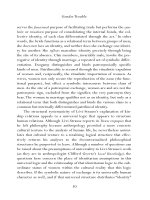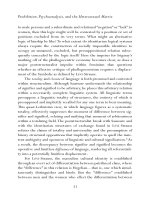GENDER TROUBLE 114
Bạn đang xem bản rút gọn của tài liệu. Xem và tải ngay bản đầy đủ của tài liệu tại đây (20.65 KB, 1 trang )
Prohibition, Psychoanalysis, and the Heterosexual Matrix
because the loss is painful, but because the ambivalence felt toward the
object requires that the object be retained until differences are settled.
In this early essay, Freud understands grief to be the withdrawal of
libidinal cathexis from the object and the successful transferral of that
cathexis onto a fresh object. In The Ego and the Id, however, Freud revises this distinction between mourning and melancholia and suggests that
the identification process associated with melancholia may be “the sole
condition under which the id can give up its objects” (19). In other
words, the identification with lost loves characteristic of melancholia
becomes the precondition for the work of mourning.The two processes, originally conceived as oppositional, are now understood as integrally related aspects of the grieving process.35 In his later view, Freud
remarks that the internalization of loss is compensatory: “When the ego
assumes the features of the object, it is forcing itself, so to speak, upon
the id’s loss by saying: ‘Look, you can love me too—I am so like the
object’ ”(20). Strictly speaking, the giving up of the object is not a negation of the cathexis, but its internalization and, hence, preservation.
What precisely is the topology of the psyche in which the ego and
its lost loves reside in perpetual habitation? Clearly, Freud conceptualizes the ego in the perpetual company of the ego ideal which acts as a
moral agency of various kinds. The internalized losses of the ego are
reestablished as part of this agency of moral scrutiny, the internalization of anger and blame originally felt for the object in its external
mode. In the act of internalization, that anger and blame, inevitably
heightened by the loss itself, are turned inward and sustained; the ego
changes place with the internalized object, thereby investing this internalized externality with moral agency and power.Thus, the ego forfeits
its anger and efficacy to the ego ideal which turns against the very ego
by which it is sustained; in other words, the ego constructs a way to
turn against itself. Indeed, Freud warns of the hypermoral possibilities
of this ego ideal, which, taken to its extreme, can motivate suicide.36
The construction of the interior ego ideal involves the internali-
79









